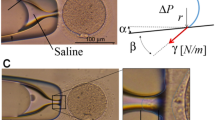Abstract
Purpose: The objective of this study was to analyze sequentially the human zona pellucida changes in an in vitro fertilization program as it relates to several variables.
Methods: The zona pellucida thickness was measured daily in zygotes and cleavage-stage embryos on a Nikon inverted microscope equipped with Hoffman modulation contrast optics, using an ocular micrometer. A total of 512 embryos from 96 patients was evaluated.
Results: There was a highly significant direct correlation between zona thickness and preovulatory estradiol and basal day 3 FSH levels (P < 0.02 andP < 0.0006, respectively). This relationship showed a rapid reversal following 48 hr of culture; embryos from patients with the highest FSH levels had thinner zonae prior to transfer (P < 0.0007). The zonae from patients with unexplained infertility were thicker (19.4 ± 2.7 µm) than those from patients with endometriosis (17.7 ± 2.2 µm), tubal (17.5 ± 2.4 µm), or male-factor infertility (16.4 ± 2.7 µm) (P < 0.0001) on the first day of culture.
Conclusions: We hypothesize that the thickness of the human zona pellucida is influenced by the preovulatory hormonal environment and diagnosis. These factors should be considered as part of the embryo quality evaluation prior to transfer or when assessing the possibility of using assisted hatching. More studies are needed to understand the factors regulating the thickness of the human zona pellucida.
Similar content being viewed by others
References
Edwards RG: Cleavage of one and two-cell rabbit eggs in vitro after removal of the zona pellucida. J Reprod Fertil 1964;7:413–415
Talansky BE, Gordon JW: Cleavage characteristics of mouse embryos inseminated and cultures after zona pellucida drilling. Gamete Res 1989;4:180–187
Malter HE, Cohen J: Partial zona dissection of the human oocyte: A nontraumatic method using micromanipulation to assist zona pellucida penetration. Fertil Steril 1989;51:139–148
Nichols J, Gardner RL: Effect of damage to the zona pellucida on development of preimplantation embryos in the mouse. Hum Reprod 1989;4:180–187
Tucker MJ, Luecke NM, Wiker SR, Wright G: Chemical removal of the outside of the zona pellucida of day 3 embryos has no impact on implantation rates. J Assist Reprod Genet 1993;10:187–91
Veeck LL: Atlas of the Human Oocyte and Early Conceptus, Vol 2. Baltimore, MD, Williams & Wilkins, 1991
Edwards RG: Conception in the Human Female. London, Academic Press, 1980
Wasserman PM: The zona pellucida: A coat of many colors. Bioassays 1987;6:161–166
Cole RJ: Cinemicrographic observation on the trophoblast and zona pellucida of the mouse blastocyst. J Embryol Exp Morphol 1967;17:481–490
Gordon JW, Dapunt U: A new mouse model for embryos with a hatching deficiency and its use to elucidate the mechanism of blastocyst hatching. Fertil Steril 1993;59:1296–1301
Bertrand E, Van den Beergh M, Englert Y: Clinical parameters influencing human zona pellucida thickness. Fertil Steril 1996;66:408–411
Spindle Al, Pedersen RA: Hatching attachment and outgrowth of mouse blastocysts in vitro: Fixed nitrogen requirements. J Exp Zool 1973;186:305–318
Fehilly CB, Cohen J, Simons RF, Fishel SB, Edwards RG: Cryopreservation of cleaving embryos and expanded blastocysts in the human: A comparative study, Fertil Steril 1985;44:638–644
Dokras Am Sargent IL, Ross C, Gardner RL, Barlow DH: The human blastocyst: Its morphology and hCG secretion in vitro. Hum Reprod 1991;6:1143–1151
DeFelice M, Salustri A, Siracusa G: “Spontaneous” hardening of the zona pellucida of mouse oocyte during in vitro culture. II. The effect of follicular fluid and glycosaminoglycans. Gamete Res 1982;12:227–235
DeFelice M, Siracusa G: “Spontaneous” hardening of the zona pellucida of mouse oocytes during in vitro culture. Gamete Res 1982;6:107–113
Downs SM, Schroeder AC, Eppig JJ: Serum maintains the fertilizability of mouse oocytes matured in vitro by preventing hardening of the zona pellucida. Gamete Res 1986;15:115–122
Schroeder AC, Schultz RM, Kopf GS, Taylor FR, Becker RB, Eppig JJ: Fetuin inhibits zona pellucida hardening and conversion of ZP to ZP2f during spontaneous mouse oocyte maturation in vitro in the absence of serum. Biol Reprod 1990;43:891–897
Longo FJ: Changes in the zonae pellucidae and plasmalemmae of aging mouse eggs. Biol Reprod 1981;25:399–411
McLaren A: The fate of the zona pellucida in mice. J Embryol Exp Morphol 1970;23:1–19
Mintz B: Control of embryo implantation and survival. Adv Biosci 1971;6:317–334
Perona RM, Wassarman PM: Mouse blastocysts hatch in vitro by using a trypsin-like proteinase associated with cells of mural trophectoderm. Dev Biol 1986;114:42–52
Garside WT, Loret de Mola JR, Bucci J, Tureck RW, Heyner S: Sequential analysis of zona thickness during in vitro culture of human zygotes: Correlation with embryo quality, age and implantation. Mol Reprod Dev 1997;47:99–104
Fowler RE, Grainge C: A histochemical study of the changes occurring in the protein-carbohydrate composition of the cumulus-oocyte complex and zona pellucida in immature mice in response to gonadotrophin stimulation. Histochem J 1985;17:1235–1249
Cohen J: Assisted hatching of human embryos. J Assist Reprod Genet 1993;8:179–190
Bertrand E, Van den Beergh M, Englert Y: Does zona pellucida thickness influence the fertilization rate? Hum Reprod 1995;10:1189–1193
Author information
Authors and Affiliations
Rights and permissions
About this article
Cite this article
Ricardo Loret de Mola, J., Garside, W.T., Bucci, J. et al. Analysis of the human zona pellucida during culture: Correlation with diagnosis and the preovulatory hormonal environment. J Assist Reprod Genet 14, 332–336 (1997). https://doi.org/10.1007/BF02765837
Received:
Accepted:
Issue Date:
DOI: https://doi.org/10.1007/BF02765837




